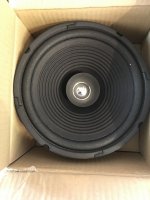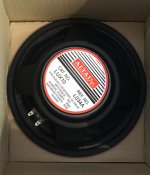Hello,
I have a pair of Altai Lux10 full range drivers.
I'd welcome any suggestions or advice on how to approach what will be my first experiment with speaker building.
Should I try and measure them first or just build a random box and see how they behave?
They have a stated frequency response of 35-12 kHz. What kind of HF performance is that likely to translate into? Should I be considering a tweeter or might these be suitable for a truly full range design? Where might I cross over?
Any and all advice, ideas and suggestions very welcome.
TIA, Haden
I have a pair of Altai Lux10 full range drivers.
I'd welcome any suggestions or advice on how to approach what will be my first experiment with speaker building.
Should I try and measure them first or just build a random box and see how they behave?
They have a stated frequency response of 35-12 kHz. What kind of HF performance is that likely to translate into? Should I be considering a tweeter or might these be suitable for a truly full range design? Where might I cross over?
Any and all advice, ideas and suggestions very welcome.
TIA, Haden
Attachments
Typically the box design follows the driver parameters. If the driver data is unobtanium, you can always measure it yourself - with the right equipment. That may set you back the cost of new drivers with known parameters - unless you're planning on making such measurements often. So measure first - build according to results.
They say 35 to 12k, but until you measure them... The frequency response measure can be a lot easier to do than the rest of the driver parameters - you'll need a quality mic and a/d, along with a computer program that can do spectrums like REW. Again the cost of which can set you back the same as buying drivers with known good frequency response.
I did a quick scan on Google and the only hit was for another Altai model selling on ebay.uk as "vintage". Maybe that would be their best fate - sell them, put the money toward something you can better and more easily work with. Read the h*ll out of DIYAudio; you'll find drivers and corresponding designs folks are quite pleased with that are surprisingly inexpensive as well. Good Luck!
They say 35 to 12k, but until you measure them... The frequency response measure can be a lot easier to do than the rest of the driver parameters - you'll need a quality mic and a/d, along with a computer program that can do spectrums like REW. Again the cost of which can set you back the same as buying drivers with known good frequency response.
I did a quick scan on Google and the only hit was for another Altai model selling on ebay.uk as "vintage". Maybe that would be their best fate - sell them, put the money toward something you can better and more easily work with. Read the h*ll out of DIYAudio; you'll find drivers and corresponding designs folks are quite pleased with that are surprisingly inexpensive as well. Good Luck!
Appears to be an Eagle as both are listed as L034A, both are the same picture, though the FR is a wide range woofer, so caveat emptor applies and better than nothing if not willing to measure your own: EAGLE L034A 25cm 8 Ohm Hifi Breitbander Breitband Lautsprecher 255mm 10" NEU | eBay
Thanks, both.
Good spot, GM. If it is an Eagle, and that appears to be the case, then there's still no sign of a datasheet with T/S parameters. That eb link gives us a resonant frequency, but muddies the water with a very different frequency range than is spec'd on the back of my pair.
Joe, thanks for your pragmatic response - I agree I could well be on a hiding to nowhere (as we say here; is that phrase used in US English?). For a first project I'm not sure I have the appetite to develop a test rig and if random flailing is unlikely to yield usable results then I agree, I should cut my losses and look for a proven route via an established project on here.
I've put them up for sale.
All the best, and thanks again for your input.
Good spot, GM. If it is an Eagle, and that appears to be the case, then there's still no sign of a datasheet with T/S parameters. That eb link gives us a resonant frequency, but muddies the water with a very different frequency range than is spec'd on the back of my pair.
Joe, thanks for your pragmatic response - I agree I could well be on a hiding to nowhere (as we say here; is that phrase used in US English?). For a first project I'm not sure I have the appetite to develop a test rig and if random flailing is unlikely to yield usable results then I agree, I should cut my losses and look for a proven route via an established project on here.
I've put them up for sale.
All the best, and thanks again for your input.

